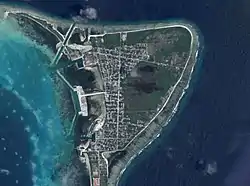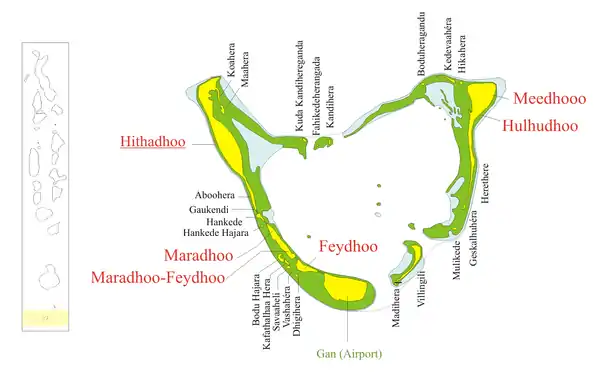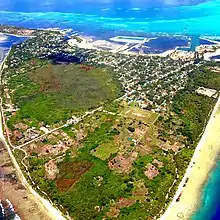Hulhumeedhoo
ހުޅުމީދޫ | |
|---|---|
District of Addu City | |
 Satellite view of the island with Meedhoo being the top (north) half and Hulhudhoo being the bottom (south) half. | |
 Hulhumeedhoo Location in Addu Atoll  Hulhumeedhoo Hulhumeedhoo (Maldives) | |
| Coordinates: 0°35′14″S 73°13′56″E / 0.587243°S 73.232281°E | |
| Country | Maldives |
| Geographic atoll | Addu Atoll |
| Administrative atoll | Seenu Atoll |
| Distance to Malé | 530 km (330 mi) |
| Area | |
| • Total | 3.2 km2 (1.2 sq mi) |
| Dimensions | |
| • Length | 2.0 km (1.2 mi) |
| Population | |
| • Total | 3,113 (Resident population) 6,394 (Registered population) |
| Time zone | UTC+05:00 (MST) |
Hulhumeedhoo (Dhivehi: ހުޅުމީދޫ) or Hulhudhoo-Meedhoo is an island located on the northeastern point of Addu City. It is the fifth largest island in the Maldives. Although Hulhumeedhoo is geographically one island, it is divided into two administrative constituencies of Addu City, known as Meedhoo and Hulhudhoo, which are roughly the northern half and southern half of Hulhumeedhoo respectively. The name "Hulhumeedhoo" is an amalgamation of the names Hulhudhoo and Meedhoo.
Meedhoo
Meedhoo (Dhivehi: މީދޫ) is the oldest populated island in Addu Atoll, having been settled between 1000 and 500 BCE.[3] Its name comes from the original Indo-Aryan settlers, the "dhoo" comes from sanskrit "dwīpa" meaning island but the meaning of "mee" is obscure.
Meedhoo is generally considered to be the northern half of Hulhumeedhoo, and has an area of 1.827 km2 and a population of 2,953 (2017).[4]
Hulhudhoo
Hulhudhoo (Dhivehi:ހުޅުދޫ) is the third most populous island in Addu Atoll. It is located on the north-east side of the atoll adjoining the island of Meedhoo to the north. The island is approximately 530 km south of Male' City, the capital of Maldives. Hulhudhoo has a population of 3,687 people (2017).[5] In the vaguely defined border dividing the island into two constituencies, Hulhudhoo is the southern half of Hulhumeedhoo. Hulhudhoo means "small island" with hulhu being the modern form of old dhivehi word "sulhu" meaning small.
Hulhudhoo spreads to an area of around 1.054 km2.[6] Hulhudhoo's landscape is mainly of palms trees and thick tropical vegetation as in other islands of the atoll. The island consists of small roads, close lanes, large number of closely built houses, only a few have a second floor, green vegetation surrounds most of the housing compounds, specially banana trees and in some households there are even taro (އަލަ) fields within the housing compound. This vegetation is regarded as part domestic agriculture and is often sent to Male' to local market.
To the south of Hulhudhoo is Herathera. An uninhabited section of the island which is located to the south, within the lagoon of Hulhudhoo. This island is linked with Hulhudhoo by bridge. The island of Maafishi, which is also located on the south of Hulhudhoo, has been linked to Hulhudhoo. Now Herathera has been developed as Canareef Island Resort.
Geography
Hulhumeedhoo's shape loosely resembles that of the letter D or even a harp. The island is the northeasternmost island of Addu City, making it the closest island to Fuvahmulah, which is located about 40 km to the northeast. The closest inhabited islands to the island, Hithadhoo, Maradhoo, Mardhoo-Feydhoo and Feydhoo (mainland Addu City) are located no more than 15 kilometers away, about 20 minutes by speedboat.
History
The original settlers were Dhivehi people of Aryan origin. An Arab traveller named Yoosuf Naib introduced Islam to the island many years before the rest of the Maldives converted to Islam, and built the country's first mosque. The island has since been known as a centre of learning and Islamic religious education.[7]
The 900 year old Kōgaṇṇu Cemetery in Meedhoo is the oldest cemetery in the Maldives.[8] The largest tombstone in the country is also found in this cemetery. It is believed that this tombstone dates back to the 18th century and belongs to a royal of the Maldives.
Education
Schools within Hulhumeedhoo include [9] Asriyya Preschool,[10] Shareefee Preschool,[11] Nasriyya Preschool and Seenu Atoll School.[12] Seenu Atoll School is the only secondary school in the island.
Landmarks
Hulhumeedhoo, being one of the oldest populated islands in the Maldives, is also home to remnants of the Second World War and even centuries-old ancient relics. Most of the ancient artifacts are found at Kogannu Cemetery, the oldest cemetery in the country, which is home to many mosques and tombs of antiquity. The island is home to World War II era remnants like coastal defense artillery and fortifications (Dhé Badi Dheythere), built on the island's eastern coast by the British based at RAF Gan as defense against Axis powers.[13]

Beaches
Some notable beaches of the island include, Eedhigamool beach, Kogannu beach, Kalhibih, Bomaa Fannu, Veyraando and Héra Burikédéthan (Ismehelaa Hera). To the south of the island is Canareef Island Resort,[14] formerly Herathera,[15] which was a part of southern Hulhumeedhoo that was dredged and separated to build a resort. To the north is a similar island, Ismehelaa Hera, also separated from Hulhumeedhoo to build a resort. This resort, named South Palm Maldives, is currently under construction.[16]
Medhebandharo
Medhebandharo (މެދެބަނދަރޮ), also synonymously known as Fasgando (ފަސްގަނޑޮ), is the central harbour of the island. It is home to MTCC Hulhumeedhoo Ferry Terminal[17] and Addu Fisheries Complex.[18]

Kilhi
Hulhumeedhoo Kilhi or Mathikilhi or simply, Kilhi (ކިޅި) is a large, marshy grassland of around 50 hectares located in the centre of Hulhumeedhoo known for its ponds. Although in this case, it refers to a marsh, "Kilhi" usually means either lake or wetland in the Addu dialect of the Dhivehi language. The ponds are known to have a few freshwater fish species including, Greenstripe Barb (Puntius vittatus)[19] and a species of swamp eel.
Kilhi has been becoming more and more popular, ever since the building of a pond named "Mathikilhi Eco Garden".[20] It has since been an icon and landmark of the island.
Wildfires
Wildfires occur in the dry, open marsh a few times every year.[21][22] The cause of ignition is usually attributed to intentional or even accidental fires, although natural ignition is also possible. In 2018, a fire in the Kilhi area destroyed the nearby WAMCO site, the island's waste management office.[23][24]
References
- ↑ "Table PP5: Resident Population by sex, nationality and locality" (PDF). National Bureau of Statistics. Retrieved 14 February 2019.
- ↑ ":TOTAL MALDIVIAN POPULATION BY ISLANDS, census 2006، 2014 and registered population 2014" (PDF). National Bureau of Statistics. Retrieved 14 February 2019.
- ↑ "Koagannu cemetery, Meedhoo island, Addu Atoll". ExploGuide. Retrieved 2017-06-21.
- ↑ "Isles - Meedhoo". Isles. Retrieved 2022-08-06.
- ↑ "Isles - Meedhoo". Isles. Retrieved 2022-08-06.
- ↑ "Isles - Meedhoo". Isles. Retrieved 2022-08-06.
- ↑ "Koagannu cemetery, Meedhoo island, Addu Atoll". ExploGuide. Retrieved 2017-06-21.
- ↑ "Koagannu cemetery, Meedhoo island, Addu Atoll". ExploGuide. Retrieved 2019-02-28.
- ↑ "Shamsuddin".
- ↑ "Makthabul Asriyya".
- ↑ "Shareefee preschool".
- ↑ "SAM".
- ↑ "Addu Atoll Islands (Seenu)". The Maldives Expert. 2018-08-21. Retrieved 2019-02-28.
- ↑ "Addu Atoll Resorts". Addu Atoll Resorts. Retrieved 2019-02-28.
- ↑ "Herathera Rebrands to Canareef Resort Maldives". 2015-10-12. Retrieved 2019-02-28.
- ↑ "Construction of Ismehela Hera to begin next month". SunOnline International. December 4, 2015. Retrieved 2019-02-28.
- ↑ "vnews - Hulhumeedhoo's Southern Transport Link terminal officially opened". Vnews.mv. Retrieved 2019-02-12.
- ↑ "Addu Fisheries Complex to begin operations in December". PSMnews.mv. Retrieved 2019-02-12.
- ↑ "Freshwater fish of Maldives". Mongabay.com. Retrieved 2019-02-28.
- ↑ "Mathikilhi Eco Garden on Instagram".
- ↑ "Fire near the Hulhumeedhoo Kulhi extinguished". SunOnline International. September 18, 2016. Retrieved 2019-02-28.
- ↑ "Fire near Hulhumeedhoo "Kulhi"". SunOnline International. September 18, 2016. Retrieved 2019-02-28.
- ↑ "WAMCO Hulhumeedhoo office burnt in fires".
- ↑ "Raajjemv News". Fire Incidents. Retrieved 2019-02-28.
External links
- Hulhudhoo - Inhabited Island - Seenu Atoll isles.egov.mv
- Meedhoo - Inhabited Island - Seenu Atoll isles.egov.mv